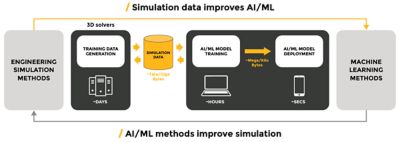-
-
Access Free Student Software
Ansys empowers the next generation of engineers
Students get free access to world-class simulation software.
-
Connect with Ansys Now!
Design your future
Connect with Ansys to explore how simulation can power your next breakthrough.
Countries & Regions
Free Trials
Products & Services
Learn
About
Back
Products & Services
Back
Learn
Ansys empowers the next generation of engineers
Students get free access to world-class simulation software.
Back
About
Design your future
Connect with Ansys to explore how simulation can power your next breakthrough.
Free Trials
ANSYS BLOG
July 5, 2023
How Artificial Intelligence, Machine Learning, and Simulation Work Together
As artificial intelligence (AI), machine learning (ML), and simulation revolutionize the way humans process and predict information, Ansys Chief Technology Officer Dr. Prith Banerjee explains how better, faster decisions are made possible when these transformational sciences align.
Q: How are AI, ML, and simulation related?
Dr. Prith Banerjee: AI/ML and simulation are distinct technologies that, when intersected, complement each other in some really powerful ways.
First, there’s AI, which creates systems that mimic human behavior that are based on rules. ML is a subset of AI that enables computers to learn the rules automatically based on training data. And then there’s simulation, which analyzes real-world products and systems through virtual models.
While they’re independent concepts, they’re continuously feeding each other. Simulations use AI and ML techniques to run models faster and easier. In turn, AI and ML use simulation to create synthetic data from a variety of industries and applications.

Q: How has AI/ML influenced the evolution of simulation?
Banerjee: The most fundamental role of simulation is to make better decisions faster, and both AI and ML are critical enablers of speed. AI/ML can enable a designer to start with a high-level specification, auto-generate 10,000 design options, and then rapidly evaluate which options are the best.
Different AI/ML approaches, including bottom-up methods, top-down methods, reduced-order models (ROMs), and large language models (LLMs), enable our solvers to perform faster, more accurate predictive analysis.
LLMs such as ChatGPT can be especially beneficial in making solvers even easier to use. For example, if one of our engineers wanted to run a simulation about an electric car, they would first have to translate the specifications for different systems (e.g., battery, motor, charger, etc.) which requires a lot of time and expertise.
But with LLMs, anyone could write an English language statement that simply states the desired outcome, such as: “Design an electric car with a 2,000-mile range that goes from 0 to 60 mph in one second.” The simulation would automatically generate a multitude of solutions for the entire car, some of which the human mind might never have considered.
AI can also improve the way we write our code. When a developer needs to upgrade our software, AI can respond with the best code snippet for solving the problem. This improves developer productivity and also enhances our customer service. By reviewing the data from thousands of customer service interactions, virtual agents can quickly provide first-level support, clearing the way for our experts to apply their minds to more atypical questions.
Q: With AI/ML integrating billions of sources, how do you ensure accuracy?
Banerjee: When a human designer takes a spec of a car, they use a lot of themselves to build it — not just their knowledge, but also their ability to reason.
When an AI models a car, it will aggregate references from a variety of sources, some of which may be unreliable, or competitors, or legally protected properties. This is part of why human monitoring and techniques like explainable AI are so important.
At Ansys, we use our own intellectual property (IP) and apply the ChatGPT engine against the database we’ve built over 50 years — things we learned through thousands of interactions between our customers and our Ansys Customer Excellence (ACE) team. To ensure confidence and accuracy, we rely on our own sources.
Q: What’s next for AI/ML and simulation?
Banerjee: When Ford started building vehicles, the manufacturing technology at the time dictated what structures they could use — such as metal forming and injection molding like rectangles and cylinders. So, everything looked the same. The idea of making a car that looks like a bird would have been difficult to imagine. But now, with generative design and additive manufacturing, it is possible to build really complex objects.
Today, Ansys is working on a ML platform where you can specify the requirements of a very complex product. The result will be the ability to generate thousands of new ideas that the human designer can’t even imagine. All these designs can be rapidly evaluated using simulation, with the best option being chosen by the human designer. When simulation and AI/ML work together, so much more is possible.
Learn more: Shaping the Future Through Artificial Intelligence and Simulation.
